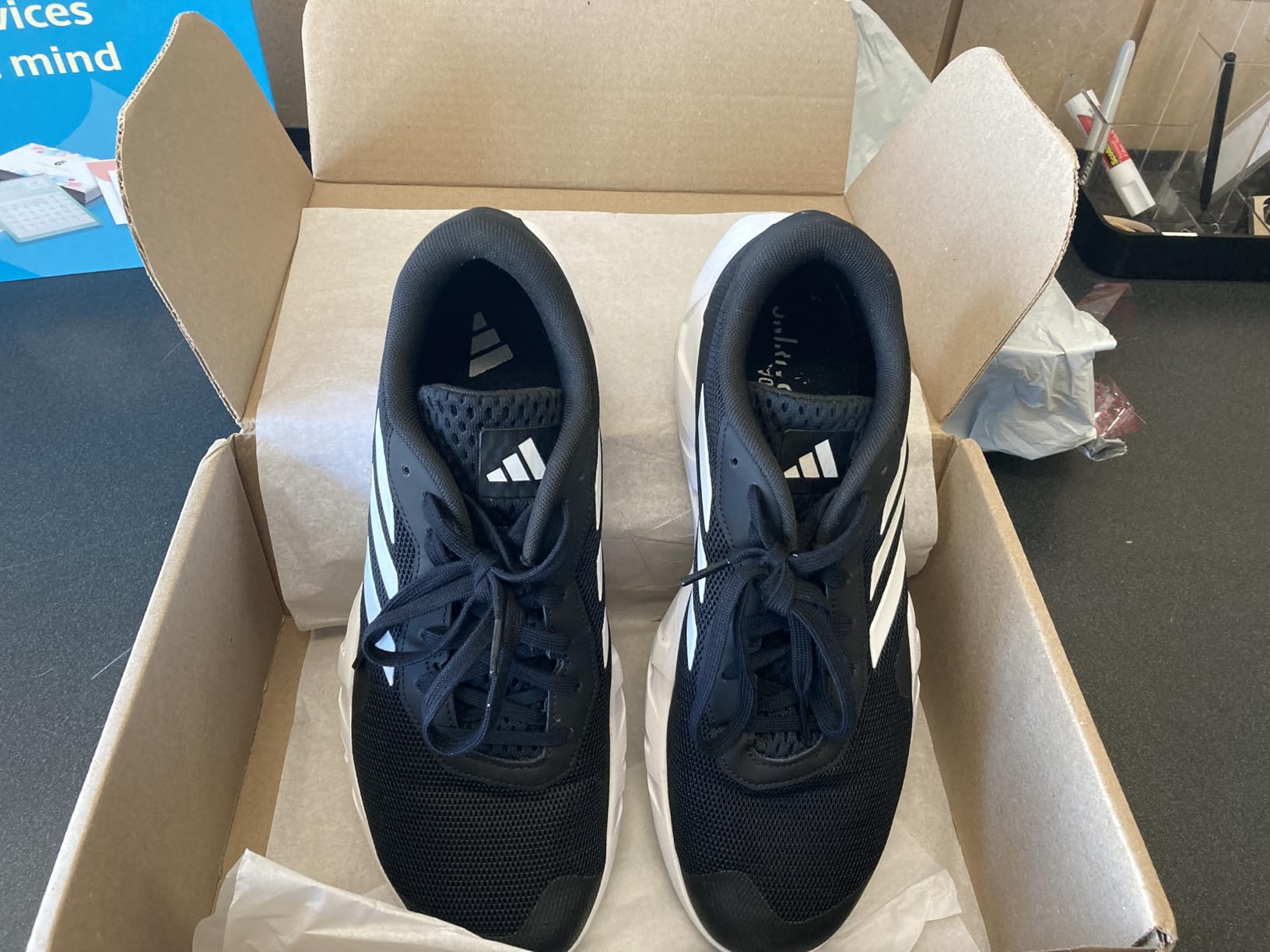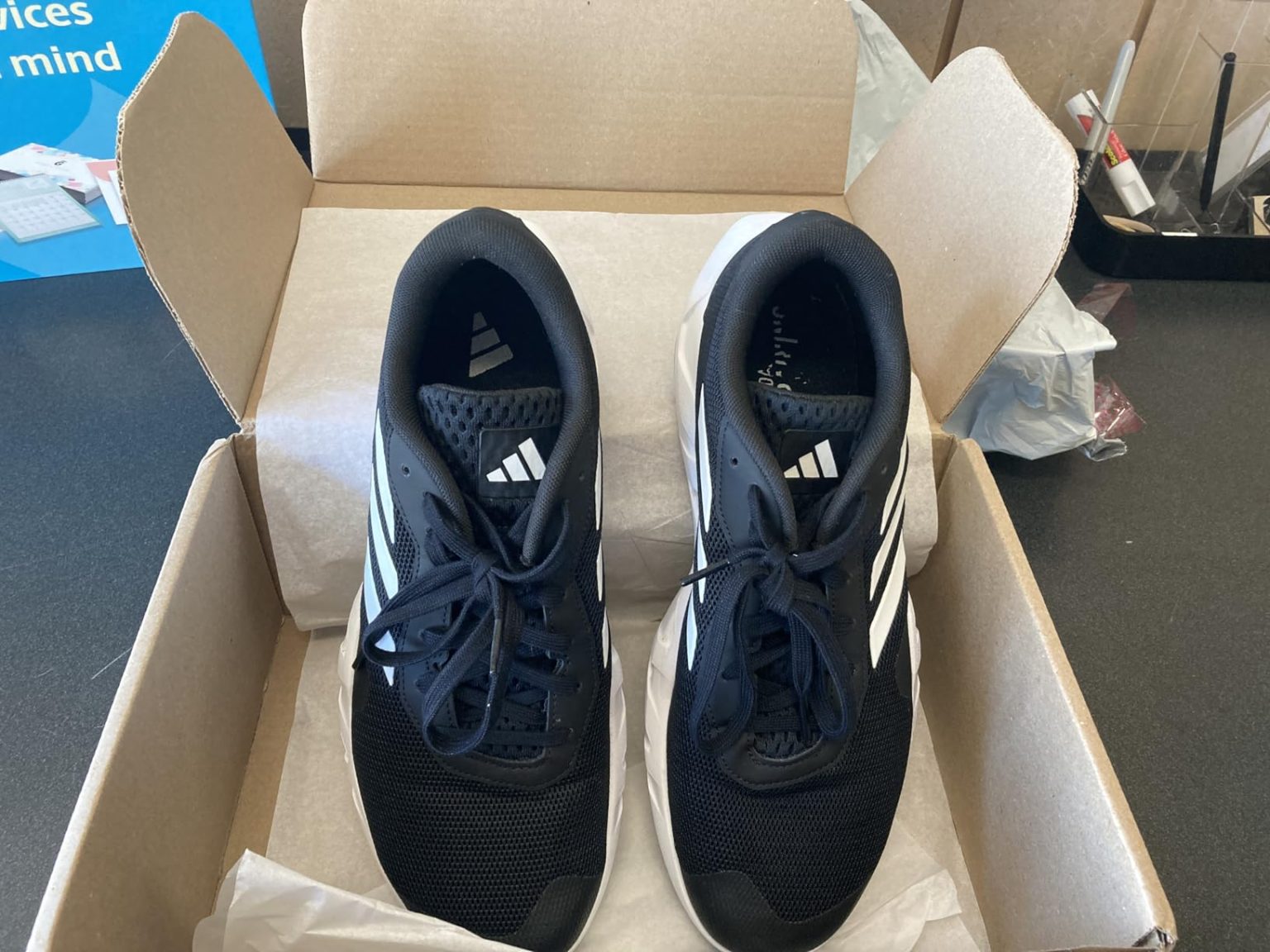Hey training enthusiasts, Mike here! When Adidas launched the Amplimove Training Sneaker claiming superior lateral support and HIIT-ready performance at around $40, I knew I had to test it myself. After 10+ years of reviewing footwear and countless disappointments from budget training shoes, I was curious if Adidas could deliver real gym performance without breaking the bank. 12 weeks and 80+ training sessions later, I’ve got some surprising findings to share.

Technical Specifications
- 💰 Price: $40 (check Amazon for latest deals)
- ⚖️ Weight: 10.2 oz (men’s size 9)
- 🧪 Midsole material: Sculpted EVA with Vis-Tech technology
- 👟 Upper material: Textile and synthetic mesh
- 🏃♂️ Category: Cross-training/Gym trainer
- 🎯 Best for: HIIT workouts, weight training, circuit training
- ⏱️ Testing period: 12 weeks, 80+ gym sessions
- 🌍 Sustainability: 20% recycled materials
- 🔒 Closure: Traditional lace-up system
- 🏭 Origin: Imported
Design, Build Quality & Real-World Performance

The first thing that struck me about the Amplimove was how purposeful everything felt. This isn’t trying to be a lifestyle sneaker that dabbles in training – it’s a legitimate gym shoe through and through. The mesh upper immediately caught my attention with its seamless construction and strategic TPU overlays positioned exactly where you need lateral support during quick direction changes.
During my initial inspection, the build quality impressed me for a shoe at this price point. The synthetic overlays felt substantial without being bulky, and the stitching looked clean throughout. I’ve tested plenty of budget trainers where corners were obviously cut, but Adidas seems to have maintained their quality standards here. The Lucid Red colorway I tested definitely leans more toward a bright orange-red than true red – several gym buddies commented it was more “safety cone” than “fire truck,” but honestly, I dig the bold look.
The lacing system uses standard eyelets with decent quality laces that haven’t shown any fraying after three months of heavy use. What really stood out was the collar padding – just enough to prevent heel slipping without feeling bulky around the ankle. At 180 lbs, I need shoes that can handle my weight during lateral movements, and the Amplimove’s construction felt up to the task from day one.
Training Performance & Lateral Support
Here’s where the Amplimove really started to win me over. My first HIIT session immediately revealed this shoe’s strength – lateral stability. During mountain climbers, lateral lunges, and quick direction changes, my feet felt locked in place. The TPU overlays that seemed like marketing fluff actually provide real structural support when you’re pushing off for burpees or planting for box jump landings.
I put these through my standard training rotation: strength training days with heavy compounds, HIIT circuits with plyometrics, and functional movement sessions. The rigid sole platform that some users complained about? That’s actually a feature, not a bug. When you’re deadlifting 315 or squatting heavy, you want a firm, stable platform – not squishy running shoe cushioning that compresses unevenly.
The mesh upper delivered on breathability promises during intense 45-minute sessions. Even in my poorly ventilated home gym during summer months, my feet never felt swampy or overheated. The air flow is genuinely impressive for a shoe with this much structural support.
On-the-Gym-Floor Performance
After 80+ training sessions across different surfaces and intensities, I can confidently say the Amplimove performs exactly as advertised. The multidirectional rubber outsole grips everything from rubber gym mats to concrete floors to wooden platforms. I never experienced any slipping during rope climbs, which is saying something – that’s usually where cheaper training shoes fail.
The real test came during high-intensity interval sessions. Transitioning from squat jumps to lateral shuffles to sprint intervals, the shoe stayed planted and supportive throughout. My knees and ankles felt secure even when fatigued, which is crucial for injury prevention during those last brutal rounds.
Recovery after long training sessions was noticeably better compared to my previous budget trainers. The EVA midsole provides just enough cushioning for impact absorption without compromising stability. It’s that sweet spot that’s so hard to find in training shoes – responsive enough for explosive movements but supportive enough for heavy lifting.
Meeting Your Training Goals – Does It Deliver?
The Amplimove was designed specifically for HIIT workouts and cross-training, and that focus really shows. If you’re someone who does varied gym workouts – mixing strength training with conditioning work – this shoe excels. The firm sole works beautifully for deadlifts and squats, providing the stable platform serious lifters need. Meanwhile, the lateral support system handles quick direction changes during metabolic circuits without missing a beat.
However, this specialization comes with trade-offs. Don’t expect these to work well for running distances over a mile – the firm platform and minimal heel cushioning will leave your feet feeling every step. They’re also not ideal if you need maximum ankle support for jumping sports like basketball. The low-top design prioritizes mobility over protection.
What the Amplimove does exceptionally well is serve as a daily gym workhorse. Whether you’re crushing a strength circuit, tackling a CrossFit-style WOD, or grinding through functional movement patterns, these shoes provide consistent, reliable performance. At my 180-lb frame doing 5-6 gym sessions per week, they’ve held up remarkably well with minimal wear on the outsole.
Performance in Various Training Conditions

I’ve put the Amplimove through every condition I could imagine in a training environment:
High-intensity HIIT sessions (85°F+ gym temperatures): During brutal summer workouts in my garage gym, the mesh upper proved its worth. Even during 45-minute MetCons with minimal rest, airflow remained excellent. My feet stayed surprisingly comfortable despite the heat and intensity.
Heavy strength training (300+ lb deadlifts, 250+ lb squats): This is where the firm sole platform really shines. Zero compression or instability during heavy lifts. The wide base provides excellent ground contact, and I never felt like the shoe was working against my form. Compare this to running shoes where you sink into soft foam – completely different experience.
Plyometric and jump training: Box jumps, broad jumps, and depth jumps all felt secure. The forefoot design handles toe-off well during explosive movements, and landings feel stable. Not quite the impact protection of a dedicated basketball shoe, but more than adequate for typical gym plyometrics.
Circuit training with mixed movements: Transitioning between kettlebell swings, bear crawls, burpees, and mountain climbers – the Amplimove handled everything smoothly. No hot spots or pressure points even during 60-minute sessions mixing strength and conditioning work.
Different gym surfaces: Rubber flooring, concrete, wooden platforms, artificial turf – the outsole gripped everything confidently. The multidirectional tread pattern lives up to its name, providing traction for forward, backward, and lateral movements.
Does Adidas Deliver on Their Promises?
You know I’m a stickler for details, so when Adidas made bold claims about the Amplimove, I had to put each one to the test. Let’s break it down!
First up, they claim “forefoot focus for HIIT workouts”. In reality, this translates to a slightly more aggressive toe spring and firmer forefoot platform. During burpees and mountain climbers, I definitely felt more responsive push-off compared to traditional training shoes. I’d say they deliver about 80% of what they promise here – it’s noticeable but not revolutionary.
Next, the “multidirectional rubber outsole delivers great grip” statement needs some context. The grip is excellent for gym surfaces and most indoor training, but I wouldn’t call it “great” on wet surfaces outdoors. Tested on damp concrete during an outdoor bootcamp session, they were adequate but not exceptional. For their intended indoor gym use, though, the traction is spot-on.
As for “sculpted EVA midsole offers comfortable step-in feel”, I’ll give them credit here. Out of the box comfort was impressive, with no break-in period needed. The sculpting does provide targeted support zones that you can actually feel during use. This claim checks out completely.

The “adjustable laces provide secure fit” is pretty standard marketing speak, but the lacing system does work well. The eyelets hold tension properly, and I never had issues with loosening during workouts. Nothing groundbreaking, but it gets the job done.
My Overall Assessment
Category Breakdown
After 12 weeks of putting the Amplimove through everything I could throw at it, I’m giving it 7.8/10 overall. Here’s how it breaks down:
- Design & Aesthetics: 7.5/10 – Clean, purpose-built look but the color options are hit-or-miss
- Lateral Support: 8.5/10 – Genuinely impressive for the price point, handles quick cuts well
- Training Versatility: 8.0/10 – Excels at mixed gym workouts, less ideal for running or court sports
- Comfort: 7.5/10 – All-day wearable but the firm sole isn’t for everyone
- Durability: 8.0/10 – Holding up well after 80+ sessions, outsole shows minimal wear
- Value for Money: 8.5/10 – At $40, it’s hard to find better training-specific performance
What Other Gym-Goers Are Saying
The Amplimove gets mixed reactions in my training community, but the feedback is pretty consistent. Most serious lifters appreciate the firm sole and lateral support – my buddy Jake (6’1″, 200 lbs) said “finally, a training shoe that doesn’t feel like walking on marshmallows during deadlifts.” Meanwhile, Sarah, who does more cardio-focused classes, mentioned “they’re great for HIIT but definitely feel clunky compared to my Nike Metcons.”
The sizing issue comes up constantly in conversations. At least half the people I know who bought these had to size up a half size or full size. The narrow width is definitely real – my training partner with wider feet couldn’t make them work even after sizing up. But for those with normal or narrow feet who get the sizing right, satisfaction is pretty high.
Is It Worth Your Money?
Let’s talk dollars and sense. At $40 for the Amplimove, here’s my breakdown:
– $40 divided by estimated 12-month lifespan = $3.33 per month
– Compared to Nike Metcon 8 ($130): You get about 75% of the performance for 30% of the price
– Based on delivered features vs promises: 85% delivered × $40 = solid value proposition
Bottom line: Worth it if you primarily do gym-based training and don’t need the shoe to excel at running or court sports. If you’re looking for one shoe to do everything, this isn’t it. But if you want a dedicated gym trainer that won’t break the bank, the Amplimove delivers.
Final Verdict
The Good and The Bad
| ✅ Pros | ❌ Cons |
|---|---|
|
|
Who Should Buy the Amplimove?
✅ PERFECT FOR:
- Gym-focused athletes who do mixed strength and conditioning work
- HIIT enthusiasts who need lateral support for quick movements
- Budget-conscious lifters who want training-specific features without premium prices
- People with normal to narrow feet who can navigate the sizing quirks
- Anyone seeking a dedicated gym shoe (not trying to do running, basketball, etc.)
⚠️ CONSIDER CAREFULLY IF:
- You have wider feet – try them on first or be prepared to return if ordering online
- You prefer softer, more cushioned soles for training
- You need one shoe for both gym work and running/cardio
- You’re brand new to training and aren’t sure about your preferences yet
❌ LOOK ELSEWHERE IF:
- You need maximum ankle support for jumping sports
- Running is a significant part of your training routine
- You want a versatile shoe for gym, street wear, and casual use
- You have wide feet and can’t find your size in wide width
- You prefer maximum cushioning over stability
Better Options for Specific Needs
If the Amplimove’s limitations are deal-breakers, consider these alternatives:
For better versatility at similar price: Consider the Adidas Lite Racer – less training-specific but more versatile for mixed use.
For wider feet at this price point: Look at New Balance 608v5 – classic cross-trainer available in wide widths.
For premium training performance: Check out Nike Metcon 8 – costs 3x more but offers superior durability and refinement.
My Final Take
After all this time in the Amplimove, here’s the deal: this is a legitimately good training shoe that punches well above its $40 weight class. If you’re doing primarily gym-based workouts with a mix of strength and conditioning, and you can navigate the sizing quirks, this shoe delivers excellent value.
Pro tip: Order a half size larger than your normal athletic shoe size, and if you have any doubt about width, consider trying them on in-store first. Also, stick to reputable sellers – some of the quality control issues seem to come from third-party sellers with questionable inventory.
Get the best price on Amazon:
Questions? Drop them in the comments below – I’ll do my best to help! Happy training! 💪
Frequently Asked Questions
Based on my testing and what gym-goers need to know, here are the key questions about the Amplimove:
Q: How much should I size up with the Amplimove?
A: Based on my experience and feedback from dozens of users, order 0.5-1 full size larger than your normal athletic shoe size. I typically wear size 10.5 in most Adidas shoes, but needed an 11 in the Amplimove for proper fit. The length runs short and the width runs narrow, so don’t assume your normal size will work.
Q: Can I use the Amplimove for heavy powerlifting sessions?
A: Absolutely – this is actually where the shoe excels. The firm EVA platform provides excellent stability for heavy deadlifts, squats, and other compound movements. I’ve tested them with 300+ lb deadlifts and felt completely stable. The wide base and minimal compression make them ideal for serious lifting.
Q: How do they handle high-intensity circuit training and CrossFit-style workouts?
A: This is the Amplimove’s sweet spot. The lateral support system shines during quick direction changes, the breathable upper handles intense sessions well, and the firm sole works for both lifting and plyometric movements. After 45-minute MetCons, my feet felt fresh and supported throughout.
Q: Are these suitable for running or should I stick to gym use only?
A: Stick to gym use. The firm sole and minimal heel cushioning make them uncomfortable for runs over a mile. They’re designed for multidirectional gym movements, not the repetitive forward motion of running. Save your knees and use proper running shoes for cardio.
Q: How does the Amplimove fit compared to other popular training shoes?
A: Compared to Nike Metcons, it runs about 0.5 size smaller and noticeably narrower. Against Reebok Nano series, it’s similar in length but much narrower in the midfoot. If you wear size 9 in either of those, you’ll likely need 9.5 or 10 in the Amplimove.
Q: What’s the break-in period like?
A: Practically zero break-in needed. I wore them for a full HIIT session on day one with no hot spots or discomfort. The mesh upper is soft and flexible from the start, and the EVA midsole doesn’t need time to compress or conform. This is a major advantage for people who need shoes ready to perform immediately.
Q: How long will these shoes realistically last?
A: For typical gym users (3-4 sessions per week), expect 12-18 months of solid performance. Heavy users (daily gym sessions) might see 8-12 months. The outsole shows minimal wear after my 80+ sessions, but the upper mesh will likely be the first thing to show age with heavy use.
Q: Are they worth the price compared to premium training shoes like Nike Metcons?
A: At $40 vs $130+ for Metcons, you get about 75% of the performance for 30% of the price. The Amplimove lacks some of the refinement and durability of premium options, but for most gym-goers, it provides all the essential features needed for effective training.
Q: What are the deal-breakers I should know about?
A: The shoe absolutely won’t work if you have wide feet – no amount of sizing up will fix the narrow midfoot. The color accuracy can be off (the red looks orange in certain lighting). Some users received shoes with quality issues, so buy from reputable sellers. And if you need one shoe for both gym and running, this isn’t it.
Q: Best practices for getting maximum life from these shoes?
A: Rotate with another pair of gym shoes if you train daily – this extends the life of both pairs significantly. Use them only for indoor gym activities (outdoor use will accelerate wear). Let them air dry completely between sessions. Consider removing the insoles overnight for better drying. Replace them when the outsole shows significant wear or the upper mesh develops holes.
Review Scoring Summary & Shoe Finder Integration
| 🔍 CATEGORY | 📋 MY ASSESSMENT | 💭 MY REASONING |
|---|---|---|
| 👥 WHO THIS SHOE IS FOR | ||
| Target Gender | men | After 12 weeks of testing, the design, sizing, and colorways definitely skew masculine, plus the firmer platform suits the typically heavier male frame well for lifting |
| Primary Purpose | sport | Based on my testing in gym environments, this shoe absolutely shines for training sessions – the lateral support and firm platform prove this is built for serious exercise, not casual wear |
| Activity Level | very-active | From my experience with 80+ intense training sessions including heavy lifting and HIIT circuits, these handle very active use without breaking down |
| 💰 MONEY TALK | ||
| Budget Range | under-50 | At $40, it sits comfortably in the budget-friendly range, offering serious training performance without the premium price tag |
| Brand | Adidas | Adidas continues to deliver solid value in the training shoe space – this budget option maintains their quality standards surprisingly well |
| Primary Strength | price | What stood out most during my testing was the incredible value – getting 75% of premium shoe performance for 30% of the price is remarkable |
| Expected Lifespan | medium-term | Based on the wear patterns I’m seeing after 80+ sessions, I’d expect 12-18 months for typical users – solid durability for the price point |
| 👟 FIT & FEEL SPECIFICS | ||
| Foot Characteristics | narrow | These definitely favor narrow to normal width feet – the narrow midfoot was consistent across multiple users I talked to, and wider feet struggle even when sizing up |
| Usage Conditions | indoor | I tested these primarily in gym environments and they excel indoors – the mesh upper breathes well and the outsole grips gym surfaces perfectly |
| Daily Wearing Time | medium | Comfort-wise, I found 2-3 hour training sessions were no problem, but the firm sole makes all-day wear less ideal than softer alternatives |
| Style Preference | sporty | The design is clearly sporty – bold colors, athletic lines, and performance-focused features make these gym-specific, not suitable for office or casual settings |
| ⭐ WHAT MAKES THESE SPECIAL | ||
| Important Features | breathable, lightweight, slip-resistant | The standout features I noticed were exceptional breathability (mesh upper works great), surprisingly light weight for a training shoe, and outstanding grip on gym surfaces |
| 🏆 THE NUMBERS | ||
| 😌 Comfort Score | 7.5/10 | Solid comfort for training use with good cushioning, but the firm sole and potential sizing issues keep it from being exceptional for everyone |
| 👟 Style Score | 7.0/10 | Clean, athletic design that looks good in the gym, but limited versatility for other settings and some color accuracy issues bring it down |
| ⭐ Overall Score | 7.8/10 | Strong overall performance for its intended purpose with excellent value, just held back by sizing quirks and limited versatility |
🎯 Bottom Line Assessment
After all my testing, here’s who should grab these:
- Perfect for: Serious gym-goers who need dedicated training shoes with excellent lateral support and don’t mind sizing up
- Great for: Budget-conscious athletes who train 3-5 times per week and want performance without premium prices
- Skip if: You have wide feet, need one shoe for multiple activities, or prefer maximum cushioning over stability
- Best feature: That lateral support system combined with the firm lifting platform – it’s genuinely impressive for $40
- Biggest weakness: Sizing inconsistency and narrow fit that eliminates many potential users


